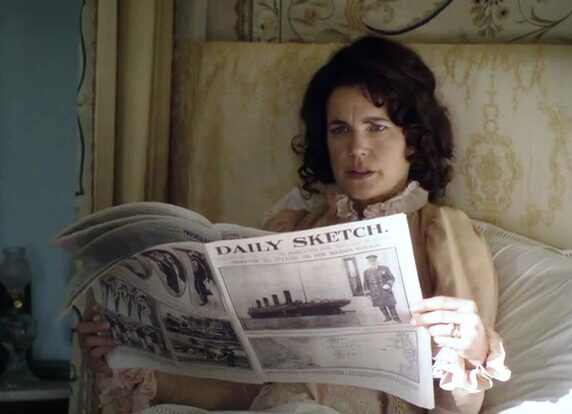
The RMS Titanic sank over 100 years ago in the North Atlantic, officially at 2:20 a.m., on April 15, about three hours after she hit an iceberg. There was huge media coverage at the 100 anniversary, focused on commemorative events in two cities which share the closest connection: Belfast where she was born and Halifax, where many of her passengers were buried. Commemorative events were held in both cities.
While media has now moved on to other stories, Titanic was a major news story for quite some time a hundred years ago. The first news travelled from ship to shore. Titanic’s transmitted distress signals “CQD, CQD”, aka”SOS”, were picked up by neighboring ships, and passed along to onshore receiving stations through Marconi wireless radio. Each new piece of information was quickly shared and before long news reached New York. With few facts, the challenge for late night editors was what to write about the story for the early edition. Had the seemingly unsinkable Titanic actually sank? The Eagle-Tribune ran a great story which explores and describes press coverage at the time. Details were later confirmed and soon newspapers around the world were covering the story.
How Downton Abbey is Connected to Titanic
Now that you have lived through a week of intense press about the shipwreck you might have gained a greater appreciation of the impact of the event which had ripple effects around the world. The very first episode of Downton Abbey opens not with the wagging haunches of Isis the dog, but with the tapping of a telegraph which carried news about the impact Titanic had on our favourite post Edwardian family.

It is interesting to note that in this drama, The London Times had not yet carried the story as a major item, but we see that Titanic was front page news in Lady Cora’s favorite tabloid, The Daily Sketch. Reading the news from freshly ironed papers, Lord Grantham observes: “Every mountain is unclimbable until someone climbs it, so the ship is unsinkable until it sinks.” It would soon become apparent that for the Crawleys, every fortune is safe until it is not. Unbeknowst to the family, Robert’s cousin James Crawley and his son Patrick were passengers on Titanic. The unthinkable happened: two heirs were lost at sea. And so began the story of Downton Abbey. Julian Fellowes is a self-proclaimed Titanorak, and felt that the famous Titanic story would be resonate with viewers, requiring less time to establish time and place. By now, his other project Titanic 2012, has been broadcast around the world, and if you saw it I did warn you, that while similar class themes were highlighted, it was really was not comparable to richness of Downton.
Halifax was Ground Zero, Dominating Headlines for Weeks
While the Crawleys gained closure quickly by holding a memorial service for their family members, many others had to wait weeks to claim their loved ones, if at all. Sadly, the recovery of Titanic’s victims was not initially top of mind with White Star. It was only after passing ships reported sightings of floating bodies, that the company succumbed to public outrage and contracted two Halifax ships, the Mackay-Bennett and Minia, to steam out to the site and see what they could find and bring back to Halifax. St. John’s, Newfoundland was closer to the wreck site, but the rail links in Halifax were better, allowing greater efficiency for grieving families to arrive, and for recovered bodies to be sent out.
Six days passed before the ships left on their grim mission, and The Mackay-Bennett returned after another two weeks at sea to a city transformed. Halifax’s flags were at half-mast, downtown shops were draped with black bunting, and the city’s hotels were filled with grief-stricken families and friends waiting to claim the remains of loved ones. Reporters were eager to see which first class passenger remains were on board.
Generally, it is agreed that 337 bodies recovered, 119 were buried at sea, 209 were brought back to Halifax. Of those, 59 were claimed by relatives (mostly those in first class) and shipped to their home communities. The remaining 150 victims are buried in three cemeteries: Fairview Lawn, Mount Olivet and Baron de Hirsch.
Titanic events this weekend in Halifax included a ceremony at the Fairview Lawn Cemetery. Legendary Canadian actor Gordon Pinsent gave a fitting tribute:
The Atlantic is both generous in sharing her bounty, and greedy in claiming her victims. We are gathered here today to commemorate the 1,500 people she indiscriminately stole from us. Tragedy, not chance, brought some of them to these shores to be buried here, far from their families, far from their homelands, far from forgotten.
There was also an address from the International Ice Patrol — an agency created in the aftermath of the Titanic disaster to monitor ice conditions in the North Atlantic, a mission it has carried out every spring and winter since 1913.
Plan a Tribute Meal
We have cooked our way through the known last menus from the First Class dining saloon, tucked into the clothing of the survivors. As well records survived for the other classes of passsengers. Your dining guide:
Lobster Thermidore
Unfortunately the menu from the À La Carte restaurant was not recovered. It was in class of its own, a place to show off the talents of Chef Rousseau. Tribute menus include dishes recalled by passengers: caviar, lobster, and plover eggs. I thought it fitting as my last Titanic dish, to prepare East Coast lobster as tribute to the heavy burden Haligonians graciously bore. Enough talk of death for one day; this version starts with the lobster already cooked and grilled.

